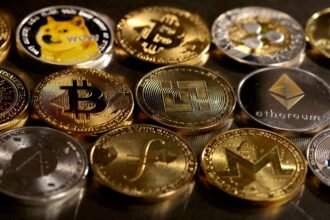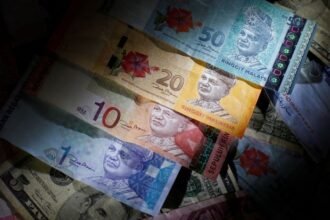Among the many disruptive economic policies former U.S. President Donald Trump is promising to pursue if he returns to the White House next year—a list that includes massive tax increases on imports, a global trade war, and an exploding budget deficit—his insistence on a weaker U.S. dollar stands out as bizarre, if not downright counterproductive.
For decades, Trump has clamored for a weaker dollar, first as a heavily indebted real-estate developer, then as a presidential candidate, then as president, and now again as a candidate for reelection. Trump’s weak-dollar push has gained support from key figures such as Robert Lighthizer, his former trade czar, who may well play a pivotal role in a second Trump administration.
Their reasoning is wonderfully simple: The dollar, they argue, is overvalued compared to currencies used by trade rivals such as China, Japan, and Europe. A weaker dollar would make imports that much more expensive for Americans and make U.S. exports that much more attractive on global markets. Voilà—a simple tweak to start balancing an out-of-balance trade deficit that for some reason is their bête noire.
The problem—there are many, but more on that later—is that pursuing such a policy would run directly counter to the one thing that Trump claims to be fighting against, and which seems to still worry Americans the most: high prices.
“It makes no sense to run against high inflation, and then advocate lower interest rates, higher tariffs, and a weaker dollar, all of which will add to inflation,” said Maurice Obstfeld, a senior fellow at the Peterson Institute for International Economics and a former chief economist at the International Monetary Fund (IMF). “It just makes no sense.”
Or, as researchers at the Brookings Institution put it when Trump toyed with the same idea when he was president: “If the objective of the U.S. administration is to worsen their trade deficit, only temporary devalue the U.S. real effective exchange rate, boost the trade balances of U.S. trading partners, support China’s economy and undervalue China’s real effective exchange rate, provide only a temporary sugar-hit to the U.S. economy, worsen global currency misalignments and provoke retaliation from their trading partners, then this policy will achieve those objectives.”
First, though, Trump and company do have a point. The U.S. dollar is a bit overvalued compared to other major currencies, no matter how you look at it—even if it tripped on the carpet Wednesday over some disappointing economic news. The IMF figured it was about 6 percent to 12 percent overvalued the last time it looked, in 2019, and big rivals such as the Chinese renminbi and Japanese yen are relatively cheap by comparison. (The yen is near 40-year lows to the dollar.)
The bigger question is why. U.S. interest rates are still on the high side to tame inflation, which explains why the yen is tanking. But a lot has to do with the fact that the U.S. dollar is the world’s reserve currency. This means that foreign central banks buy and hold dollars, like everyone else in the global economy, which props up their value. U.S. securities, such as government debt, remain the absolute safe haven for investors in times of trouble, even when those troubles emanate, like during the 2008-09 financial crisis, from the United States. That demand props up the dollar. Massive fiscal deficits in the United States, such as that caused by Trump’s $1.9 trillion tax cut, require foreign funding to finance. That demand props up the dollar.
But the problems with pursuing a weak-dollar policy remain legion, even if the policy were actually workable.
For starters, a weaker dollar would neither put a governor on U.S. imports nor turbocharge U.S. exports, which is the explicit goal of the entire approach. In the very short term, a cheap-money, weak-dollar policy would boost U.S. economic growth, which would put money in consumers’ pockets, which would lead to an uptick in imports. That is why the U.S. trade deficit widens when times are good at home—consumers are flush.
But more importantly for Trump and Lighthizer’s case, a weak dollar would do little to boost U.S. exports. There are all sorts of things beyond the marginal value of the dollar that stand in the way of U.S. goods elbowing their way into foreign markets, from non-tariff barriers and regulatory regimes (no chlorinated chicken in Europe, please) to consumer preferences; massive trucks with poor gas mileage are a terrible fit in a place like Europe with pricey petrol and narrow roads.
The biggest reason, though, is that in the modern world of global supply chains, the ability of the value of any country’s currency to affect the level of exports is quite small. Products are made with inputs from foreign countries, sold to other countries, often re-imported, tinkered with again, and exported again somewhere else. The upshot is that in a globalized world, supply chain intermingling makes the value of the export currency increasingly irrelevant.
Another problem is that the easiest way to force the dollar down is by lowering U.S. interest rates, one of Trump’s long-standing obsessions. The one thing that axiomatically follows lower interest rates (unless you are Japan) is higher inflation, which is exactly what Trump and his acolytes have been bashing U.S. President Joe Biden over for years.
And there is a national security component, too. The United States maintains about 800 overseas military bases in more than 70 countries, which collectively underpin a globe-spanning projection of U.S. power. That is kept running day to day by spending dollars on fuel, power, supplies, and a million other things. The weaker the dollar is, the more expensive it would be to maintain the country’s sprawling overseas commitments, which sits rather awkwardly with Trump’s advisors’ plans for “peace through strength” overseas.
But Trump’s plans for a weaker dollar would be hard to realize in any event, which makes the whole exercise befuddling.
Take the Chinese currency, which, despite years of scolding from U.S. officials before, during, and after Trump, keeps getting cheaper in relative terms. The renminbi is partially pegged to the dollar. If the dollar goes down in value, the renminbi will follow it down like George Costanza’s rock-climbing partner. Other countries can equally stand aside and let their own currencies slide a bit to offset the dollar’s move, and everything goes back to square one.
Then there is the tariff angle. Trump has already vowed tariffs on every country in the world, and especially on China. The last time he did that, China and Europe retaliated in kind. Foreign tariffs would erase absolutely any tiny advantage gained by a cheaper dollar.
And then there is the exploding deficit. One-quarter of the entire U.S. national debt was accrued during Trump’s term, in part due to his massive unfunded tax cuts. He promises to double down in a second term, with more unfunded tax cuts that can only be filled by enticing foreign investors to pay for them—which requires higher yields on U.S. government debt, which would then act to push the dollar back up again, undoing all the work he just tried to do.
So why, knowing what we know about the pitfalls and perils of a weak-dollar policy, is this such a Trump priority? It seems that the lodestars for Trump and his economic brain trust are found in years past, and none of them are particularly good for learning economic lessons.
Trump himself seems keen on replaying the 1930s, not exactly a golden time for the U.S. and global economies. His love of tariffs is well known, but it takes a special breed to make worship of the infamous 1930 Smoot-Hawley tariff the hill to die on. He couples that with a love of competitive devaluation of currency to get a trade advantage, another tactic that featured heavily in 1930s beggar-thy-neighbor economic thought (though recent research suggests competitive devaluation only slightly beggared some neighbors and tariffs were a greater evil).
Lighthizer last took his bearings in the 1980s, when the Reagan administration strong-armed Japan over trade, imposed trade restrictions that raised prices and lowered choice for U.S. consumers, and got European allies to help deflate an admittedly overheated dollar with the Plaza Accord, named after the New York hotel in which Trump once made a cameo in a Christmas movie.
But that was, Obstfeld said, a very different time. The dollar was wildly overvalued, there was no common European currency, and Europe was utterly dependent on the U.S. security umbrella during the Cold War. Trump previously threatened to pull out of NATO (and now says he’ll only stay as long as European countries pay their share), refuses to commit to collective defense, and has already started a trade war once with those allies. None of the levers that did the lifting back then are even around today.
Trump has been chasing a weaker dollar for decades and didn’t manage to get there during his chaotic term. He may not get there again, even if he gets to the White House again. But it is a reminder that beyond the crimes and the misdemeanors and the worries about everything else, there are literally dollars and sense at stake this November.
“I just don’t see how the United States can stand alone and be strong. It is all back to the 1930s and isolationism,” Obstfeld said. “It is so misguided.”





















